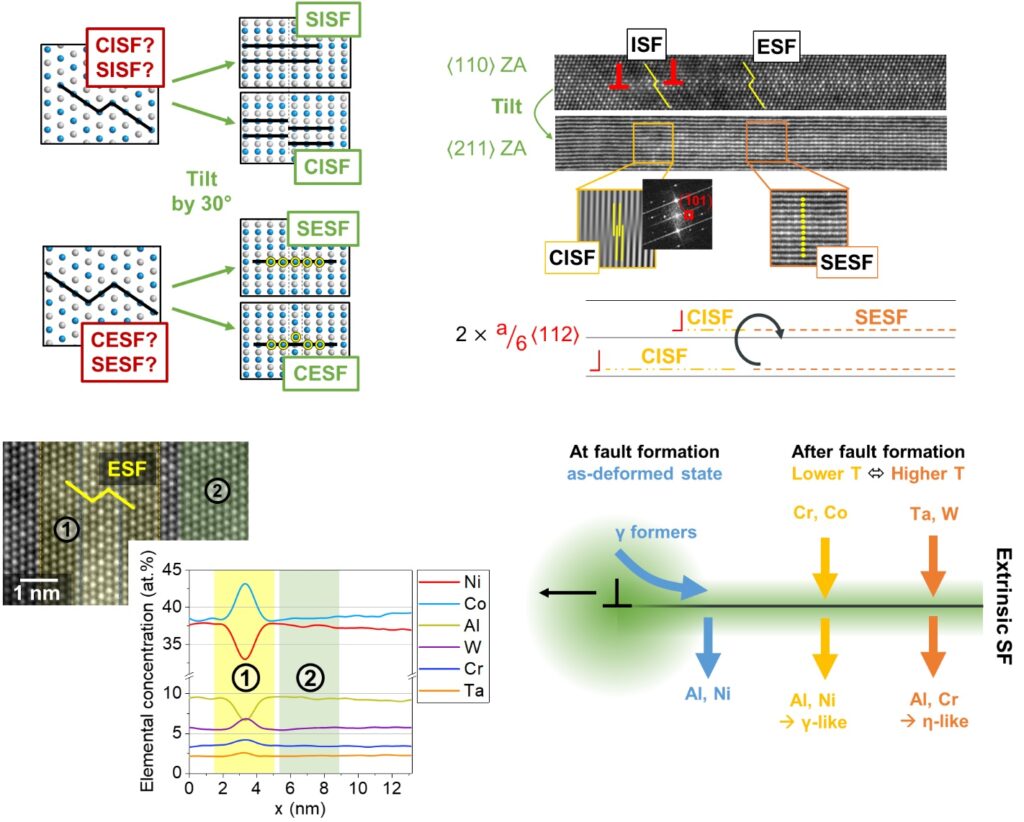Highlights from Superalloys 2024
We are proud to announce two paper contributions to the 15th International Symposium on Superalloys, which took place from September 8th-12th, 2024, in Seven Springs, Pennsylvania (USA). Both contributions enhance our understanding of stacking faults, a critical aspect of high-temperature deformation in superalloys. These works are the culmination of over a decade of research persued by professor Spiecker on innovative microscopy approaches to resolve the detailed structure of defects and unraveling deformation mechanisms in superalloys, which involve complex diffusion processes. The research was supported by the SFB-TR103 project and conducted in collaboration with colleagues from WW1 and Ruhr-Universität Bochum.
Doctor student Mr. Nicolas Karpstein participated in the prestigious event, representing IMN, and presented the two work this year. For his poster presentation on “Temperature and Time Dependence of Elemental Segregation at Stacking Faults in Ni- and Co-base Superalloys,” he was honored with one of only two Best Interactive Presentation Awards. This research examined how the enrichment and depletion of specific alloying elements at stacking faults—an effect that plays a pivotal role in the mechanical properties of superalloys—varies with temperature and annealing duration. Congratulations, Nicolas!
The first contribution addresses analyzing stacking fault structures in the L1₂-ordered γ′ phase through high-resolution Scanning Transmission Electron Microscopy (STEM). Traditionally, such analyses are performed in the [110] projection, which allows for distinguishing between intrinsic and extrinsic stacking faults and determining the projected Burgers vectors of dislocations. However, this projection alone cannot reliably identify whether a stacking fault is complex or not, which is a crucial factor in understanding deformation mechanisms, including atomic-scale reordering processes.
To overcome this limitation, our team developed a method to tilt the fault structure by 30° into a neighboring [211] projection, enabling the identification of complex faults and the precise determination of Burgers vectors. We demonstrated the effectiveness of this approach through two key examples:
- Experimental verification of the Kolbe mechanism for SESF formation in a Co-base superalloy.
- Microscopic insights into the shear-based phase transformation from the γ′ phase to the χ phase, commonly observed in Co-base superalloys within the Co-Al-W ternary system.
This new method promises to enhance our understanding of deformation at the microscopic scale in superalloys and other materials.
The second contribution explores the elemental segregation at stacking faults in the γ′ phase of superalloys, a process that can significantly influence the mechanical behavior of the alloy. This segregation can either degrade or improve the alloy’s mechanical properties depending on the local composition at the fault. Our study investigates the time and temperature dependence of elemental segregation at extrinsic stacking faults in both Ni-base and Co-base superalloys. We measured fault compositions immediately after deformation and after additional load-free annealing at various temperatures and durations.
Key findings from this study include:
- Elemental segregation is dynamic and continues to evolve after fault formation.
- Lower temperatures promote a more γ-like fault composition, which weakens the alloy, while higher temperatures promote an η-like composition, which strengthens it through a process known as “local phase transformation strengthening.”
These insights could be instrumental in further optimizing superalloy compositions and heat treatment processes for enhanced performance.

Both contributions were presented at the Superalloys 2024 conference and have been published in the conference proceedings. They can be accessed via the following links:
The papers will soon be available via the Superalloys Proceedings Archive on the TMS website: Superalloys Proceedings Archive

